Student Achievement
Criteria, Thresholds and Outcomes
The mission of TAMIU is to nurture its students’ academic and social development to be responsible and productive members of our global society. TAMIU contributes to this mission through the strategic plan goals, specifically through Strategic Plan Goal 2: Empowered Student Success and Wellness and Strategic Goal 4: Transformative International Experience.
In its Student Achievement Core Requirement 8.1 (CR 8.1), the Southern Association of College and Schools Commission on Colleges (SACSCOC) requires institutions identify and publish Student Achievement criteria, goals, thresholds of acceptability and outcomes.
Student Achievement Criteria identified by TAMIU are first-year persistence rate, undergraduate graduation rates, completions by Economically Disadvantaged Students, total degrees conferred, and first-attempt licensure passing rate. These criteria are measured by IPEDS and EmpowerU fall-to-fall Cohort Retention, 4-year, 6-year, and 8-year Undergraduate Graduation Rate, 6-year Undergraduate Graduation Rate, and Licensure Passing Rates for Teacher Certification and NCLEX. Thresholds and aspirational goals for these measures are below.
Information regarding institutional performance on these measures follows in the drop down menus below.
Student Achievement Reports
- Lamar University
- Prairie View A&M University
- Tarleton University
- Stephen F. Austin State University
- West Texas A&M University
| Measure | Threshold | Threshold of Acceptability Status | Goal | Goal Status |
|---|---|---|---|---|
| First-Year Persistence Rate | 69% | Met | 80% | Not Met |
| 4-Year Graduation Rate | 29% | Not Met | 38% | Not Met |
| 6-Year Graduation Rate | 44% | Met | 55% | Not Met |
| 8-Year Graduation Rate – Student Completion Indicator for SACSCOC | 52% | Not Met | 54% | Not Met |
| 4-Year Non-First Time Entering (Transfer) Graduation Rate | 57% | Not Met | 65% | Not Met |
| Percent Completions by Economically Disadvantaged Students | 996 | Met | 1052 | Met |
| Total Degrees Conferred | 1621 | Met | 1861 | Met |
| State Licensure Pass Rates - Nursing (NCLEX) | 80% | Met | 98.03% | Not Met |
| State Licensure Pass Rates - Teacher Certification | 80% | Met | 90% | Not Met |
Definition: The percentage of first-time, full-time students seeking bachelor’s degrees who returned to Texas A&M International University for their second year (fall-to-fall retention).
Source: EmpowerU, IPEDS, and TAMIU Institutional Research Office
Threshold of Acceptability: The average rate of the prior cohort year for the five similar universities. Five similar universities are provided to the TAMU system by the Texas Higher Coordinating Board.
Goal: Stretch Goal set by Institution and reported by A&M System
Status for Current Year: Above the threshold of acceptability but below the goal.
Figure 1
First-Year Persistence Rates by Cohort
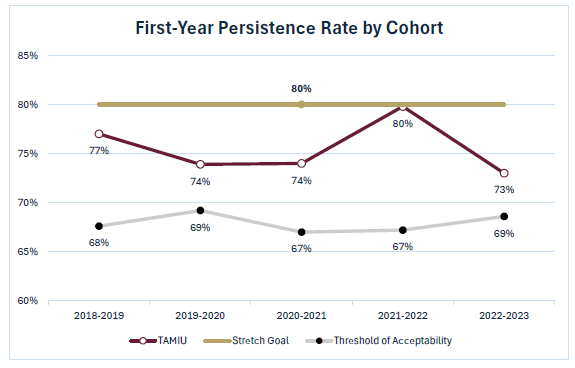
Figure 2
First-Year Persistence Rate by Cohort and Sex
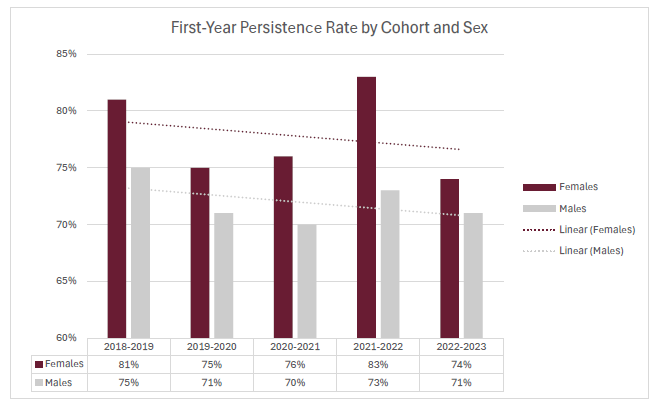 Figure 3
Figure 3
First-Year Persistence Rate by Cohort and Race/Ethnicity
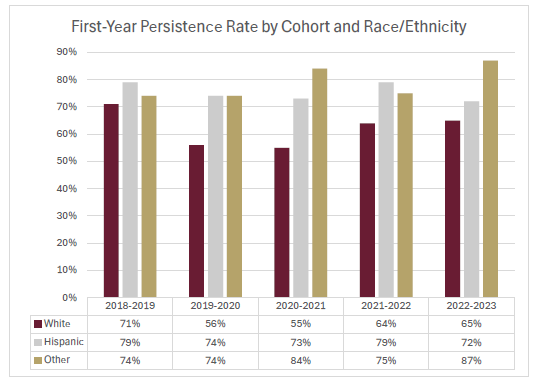
Figure 4
First-Year Persistence Rate by Cohort, Sex, and Race/Ethnicity
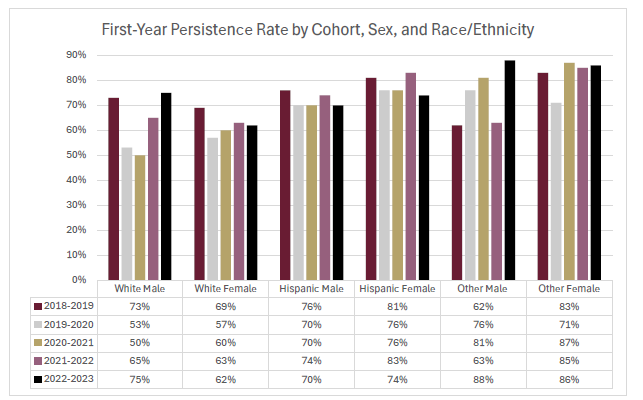
Definition: The percentage of first-time, full-time students seeking bachelor’s degrees who graduated from TAMIU within 4 years.
Source: EmpowerU, IPEDS, THECB, and TAMIU Institutional Research Office
Threshold of Acceptability: The average rate of the prior cohort year for the five similar universities. Five similar universities are provided to the TAMU system by the Texas Higher Coordinating Board.
Goal: Stretch Goal set by Institution and reported by A&M System
Status for Current Year: Prior to COVID, graduation rates were above the acceptable threshold but below the goal. Four-year graduation rates (Figure 5) averaged around 25 % before spiking 7 points for the 2016 cohort. The 2017 cohort experienced a slight dip, and again in 2018, they turned up for the 2019-2020 cohort. Unfortunately, the dip for the 2017 cohort is when we fell below the threshold of acceptability and have not been able to climb above it.
Figure 1
4-Year Graduation Rate by Cohort Year
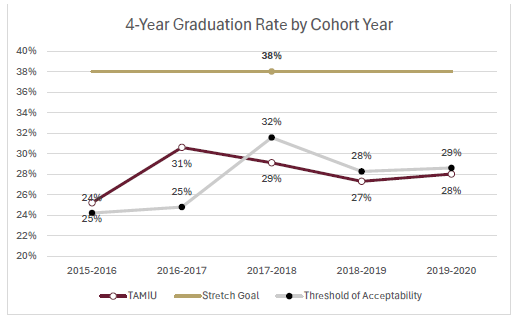 Figure 2
Figure 2
4-Year Graduation Rate by Cohort and Sex
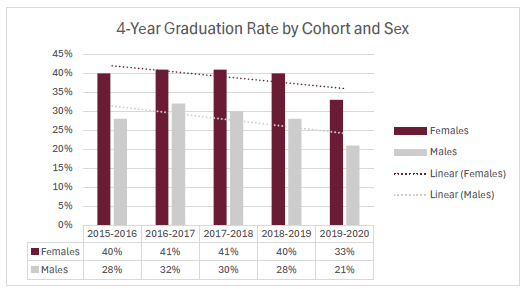
Figure 3
4-Year Graduation Rate by Cohort and Race/Ethnicity
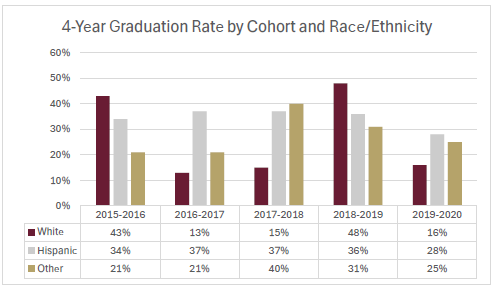
Figure 4
4-Year Graduation Rate by Cohort, Sex, and Race/Ethnicity
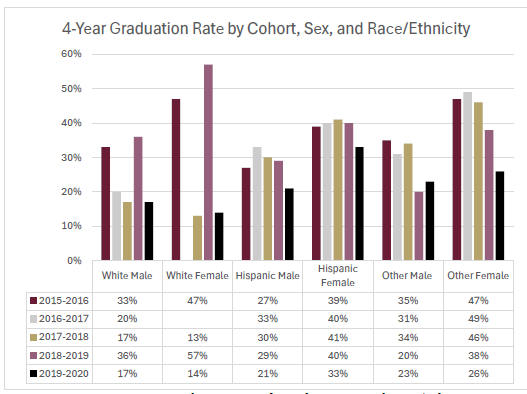
Definition: The percentage of first-time, full-time students seeking bachelor’s degrees who graduated from TAMIU within 6 years.
Source: EmpowerU, IPEDS, THECB, and TAMIU Institutional Research Office
Threshold of Acceptability: The average rate of the prior cohort year for the five similar universities. Five similar universities are provided to the TAMU system by the Texas Higher Coordinating Board.
Goal: Stretch Goal set by Institution and reported by A&M System
Status for Current Year: Above the threshold of acceptability but below goal.
Figure 1
6-Year Graduation Rate by Cohort Year
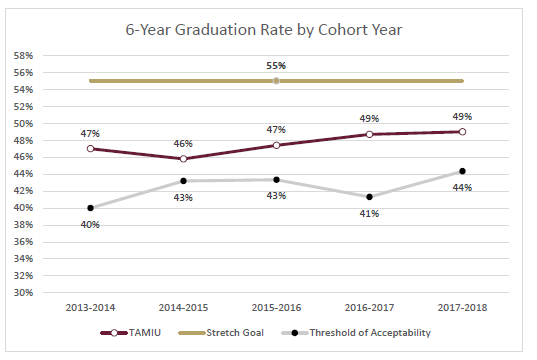
Figure 2
6-Year Graduation Rate by Cohort and Sex
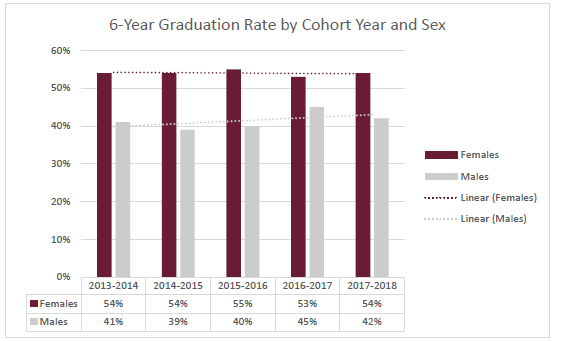
Figure 3
6-Year Graduation Rate by Cohort and Race/Ethnicity
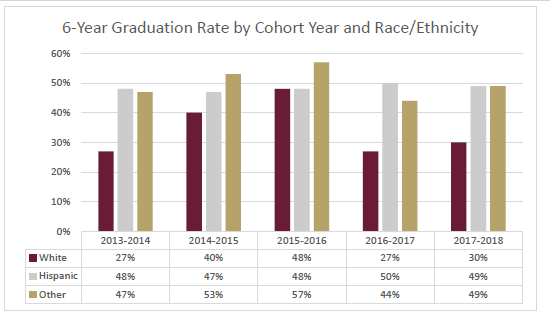
Figure 4
6-Year Graduation Rate by Cohort, Sex, and Race/Ethnicity
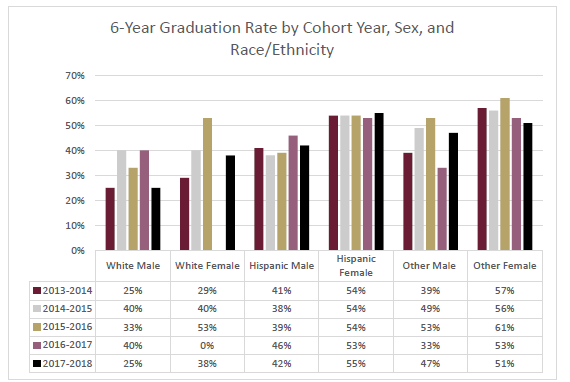
Definition: The percentage of first-time, full-time students seeking bachelor’s degrees who graduated from TAMIU within 8 years.
Source: TAMIU Institutional Research Office
Threshold of Acceptability: 52.1% base rate provided by SACSCOC, based on 2016 preliminary data, and provided in the summer 2018
Goal: 2% above Threshold
Status for Current Year: Below the Threshold and Goal
Figure 1
8-Year Graduation Rate by Cohort Year
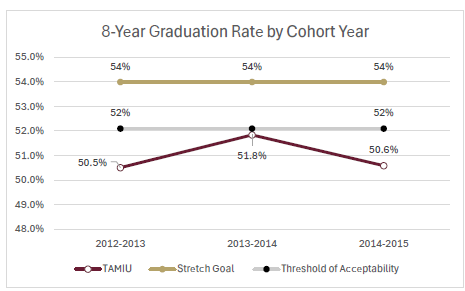
Figure 2
8-Year Graduation Rate by Cohort and Sex
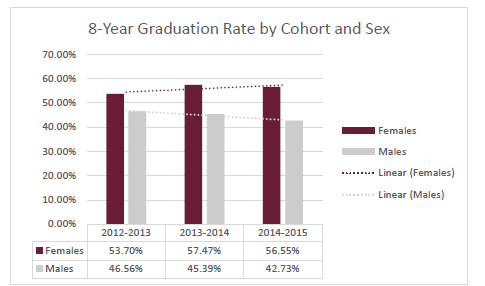
Figure 3
8-Year Graduation Rate by Cohort and Race/Ethnicity
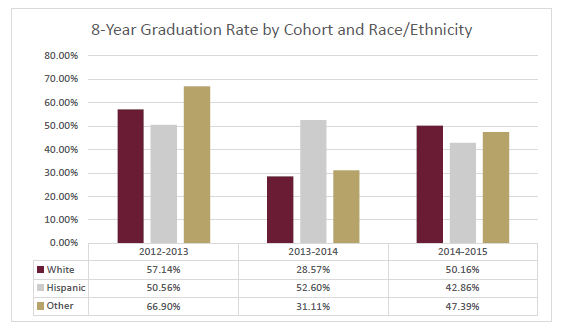
Figure 4
8-Year Graduation Rate by Cohort, Sex, and Race/Ethnicity
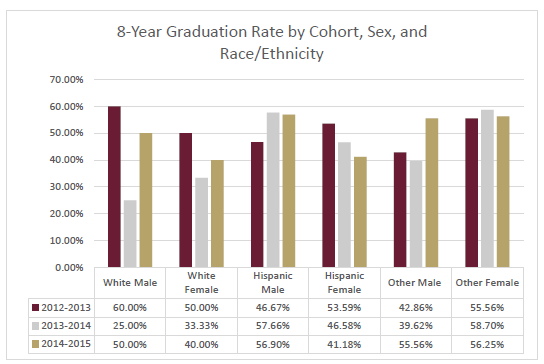
Definition: The percentage of full-time non-first-time entering students by cohort year who pursued bachelor’s degrees and who graduated from Texas A&M International within 4 years.
Source: TAMIU Institutional Research Office and Texas Higher Education Coordinating Board
Threshold of Acceptability: The average rate of the prior cohort year for the five similar universities. Five similar universities are provided to the TAMU system by the Texas Higher Coordinating Board.
Goal: Stretch Goal set by Institution and reported by A&M System
Status for Current Year: Graduation rates were above the acceptable threshold but below the goal until 2018, falling below the threshold for the past two cycles. However, remember that the threshold is from the comparable universities’ previous year’s data and, therefore is somewhat matches our previous year’s as well.
Figure 1
4-Year Non-First Time Entering (Transfer) Graduation Rate by Cohort Year
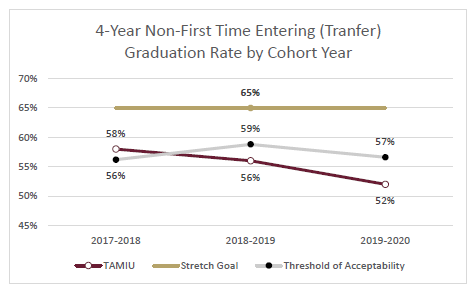
Note: Data was only available to compare these cohorts, hence the three years of data.
Figure 2
4-Year Non-First Time Entering (Transfer) Graduation Rate by Cohort and Sex
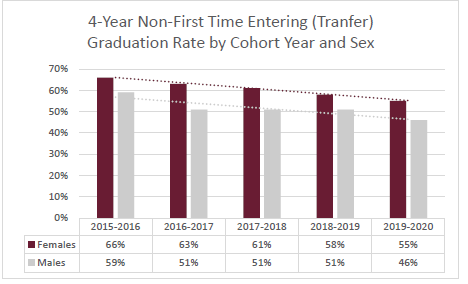
Note: Data was only available to compare these cohorts, hence the three years of data.
Figure 3
4-Year Non-First Time Entering (Transfer) Graduation Rate by Cohort and Race/Ethnicity
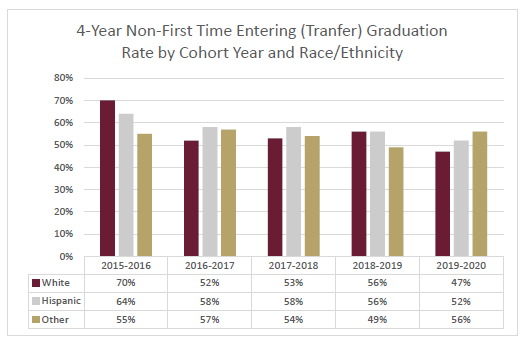
Note: Data was only available to compare these cohorts, hence the three years of data.
Figure 4
4-Year Non-First Time Entering (Transfer) Graduation Rate by Cohort, Sex, and Race/Ethnicity
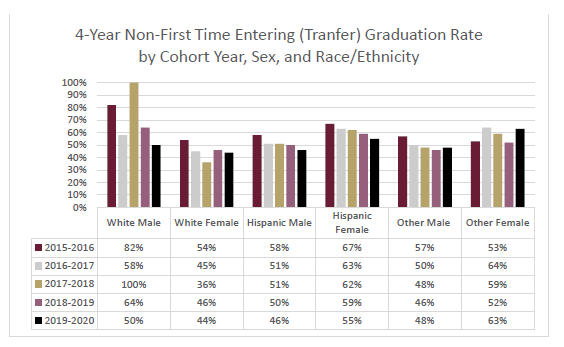
Note: Data was only available to compare these cohorts, hence the three years of data.
Definition: The number of bachelor’s degrees awarded to economically disadvantaged students—those receiving Pell Grants at any time.
Source: TAMIU Institutional Research Office and Texas Higher Education Coordinating Board
Threshold of Acceptability: Started with first year of data (2016-2017) with 2% growth each year
Goal: A target of 2% growth each year
Status for Current Year: Above the threshold of acceptability but below the goal.
Figure 1
Completions by Economically Disadvantaged Students
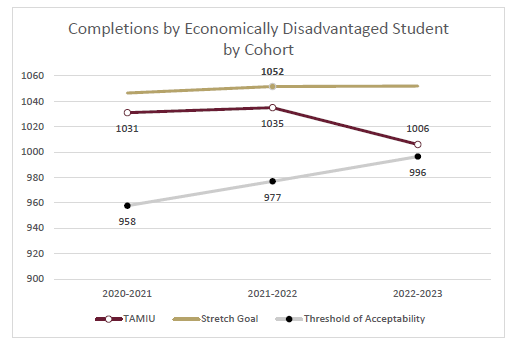
Note: Data was only available to compare these cohorts, hence the three years of data.
Definition: The number of bachelor’s and graduate degrees awarded.
Source: TAMIU Institutional Research Office, EmpowerU, and IPEDS
Threshold of Acceptability: Threshold started with the first year of data (2016-2017), at 2% growth each year. The university changed to 5% after continuous growth for four academic years.
Goal: 5% growth each year. The goal will not decrease if the numbers fall below the goal but will be maintained.
Status for Current Year: Above both the Threshold and the Goal.
Figure 1
Total Degrees Conferred by Academic Year
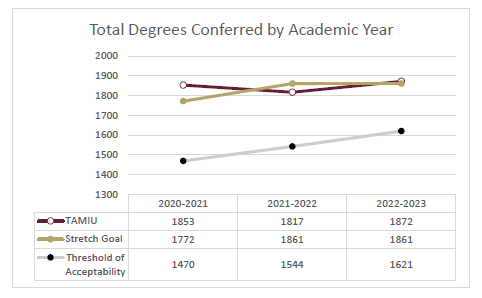
Note: Data was only available to compare these cohorts, hence the three years of data.
Figure 2
Total Undergraduate Degrees Conferred by Academic Year
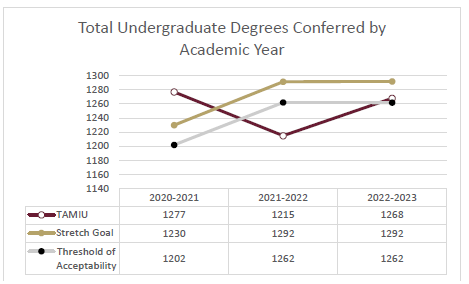
Note: Data was only available to compare these cohorts, hence the three years of data.
Figure 3
Total Graduate Degrees Conferred by Academic Year
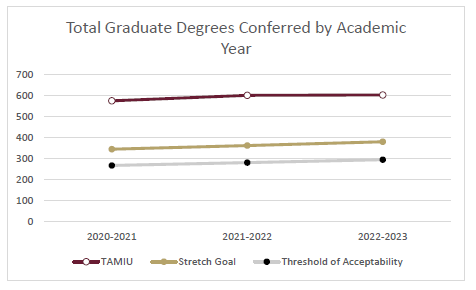
Note: Data was only available to compare these cohorts, hence the three years of data.
Figure 4
Total Degrees Conferred by Sex
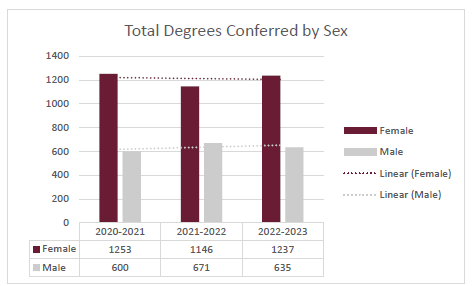
Note: Data was only available to compare these cohorts, hence the three years of data.
Figure 5
Total Degrees Conferred by Sex and Race/Ethnicity
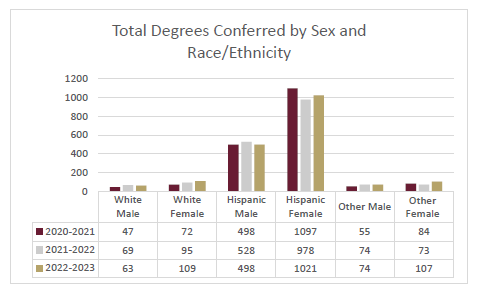
Note: Data was only available to compare these cohorts, hence the three years of data.
Definition: The percentage of students who passed the National Council Licensure Examination–RN (Registered Nurse).
Source: Texas Board of Nursing
Threshold of Acceptability: Determined by the Accreditation Commission for Education in Nursing (ACEN)
Goal: A Target of one percent growth each year. The goal will not be decreased if numbers fall below the previous year’s numbers but will be maintained.
Status for Current Year: Above the Threshold but below the Goal.
Figure 1
Texas Board of Nursing National Council Licensure Examination - RN (Registered Nurse) Pass Rates
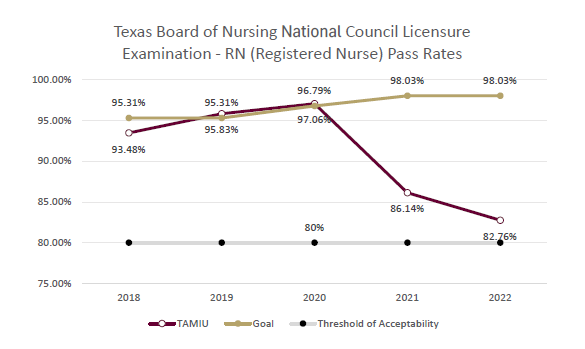
Definition: The percentage of teacher candidates who finish a traditional program and obtain a standard teaching certificate within 1 year of graduating with a bachelor’s degree.
Source: Texas Education Agency (TEA)
Threshold of Acceptability: Determined by the State Board for Educator Certification (SBEC) and TEA
Goal: Determined by SBEC and TEA
Status for Current Year: Above the Threshold but below the Goal.
Figure 1
Teacher Certification Rate within One Year of Graduation

Contact
Office of Institutional Assessment, Research and Planning
5201 University Boulevard, Sue and Radcliffe Killam Library 434, Laredo, TX 78041-1900
Phone: 956.326.2275